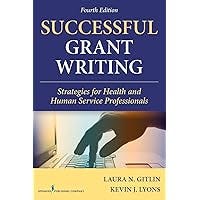Book Review of “Successful Grant Writing: Strategies for Health and Human Services Professionals,” 4th ed., 2014, by Laura Gitlin and Kevin Lyons. New York: Springer Publishing. Paper, 348 pages.
This is a serious book for big grant dollars, major research projects, and important interventions…
Helping the unhoused persons on the street, providing funds for training and education of new social workers, and finding the means to alter communities are all important endeavors. How can we do such things with limited funds, high costs, and interference from those who would thwart our work? Perhaps major grant funding is the most important way to leverage the change we hope to see.
A wide range of professionals can benefit from this clear book on grant writing. Whether you are a researcher, a professor of social work, or a community advocate needing to access dollars for programs and research, this is a great source. It is a good reference, great for use as a textbook, and adaptable for use in professional development sessions.
Gitlin and Lyons provide here one of the clearest and most comprehensive books on grant writing I have ever read. They cover not only the actual writing of the application or the proposal but also the steps proceeding it such as the planning and the steps following it.
The authors show clearly how grant writing is part of professional activity and also part of one’s career trajectory over time. Grant writing is not a basic skill or a simple activity. It is, instead, the result of longer-term insight, careful planning, and in-depth thinking. A grant [proposal is part of problem solving. It is not simply a device for getting money.
The organization of the book is clear and like many such guides begins with the brainstorming and planning stages and goes through the stage of spending the money to perform the grant activities. However, that is where the similarities to other books end. This book is much better, much more detailed, and therefore much more helpful.
This book is for major serious grant projects. The authors include some very important aspects, steps, and factors ignored by the writers of other books on grants For example, chapter four talks about the structure of an organization and who is responsible for what (starting on p. 63). This is essential for a new grant writer to know. Another important chapter tells you how crucial it is for you to discover who in your institution will help you with the fine details of the grant proposal (starting on p. 229). If your organization does not have several people to help you understand overhead costs and how to administer the grant once you receive it, you need to either help get such people hired or consider writing a simpler grant.
Another option is to create a more supportive grant writing culture within your institution and do what you can to get people on board to help. As a new grant writer, you can profit from getting the assistance of other professionals in your institution. Another benefit is working with them to help get funded. Yet another form of assistance is seeking specific advice from experienced grant writers (p. 14).
You may also wish to hire a consultant who is familiar with the type of project you propose or who reviews proposals for federal agencies on a regular basis. It is ethical to pay them for their editing or their overall advice—at whatever level you seek. At the time of this writing, I just got done helping guide a local consortium of schools and community agencies in planning a major proposal for a federal grant opportunity. I will be paid for my work in helping plan the proposal, as will some of the other members of the planning team working on the grant.
The authors give other good advice in the book, such as the importance you attach to planning, revising, and revisiting your project goals and scope. Not all projects are easy to find funding for, and sometimes a brief and focused chat with a program officer will help you know early on in the planning whether you are heading down the right path.
Most of the general advice here applies to many of the federal funding sources and also to foundations you may come across as you search for grant dollars. There is even a chapter here on how to search for funds, including search engines that are free, sources such as professional organization newsletters and webpages listing grant programs, and some search engines to which you can pay to be a subscriber.
The book is full of great ideas, resources, and references.
While the book does contain grant information from various federal offices and agencies, there is a clear emphasis on the National Institutes of Health (NIH) here. The author talks about many grant traditions at NIH, including the rules regarding how many times you may submit the same proposal (p. 320). Some of the federal agencies have no such rules. As a reviewer, I often see proposals that I feel fit a different competition better and may have been revised to fit another. In that case, I have to review the proposal at hand and ignore my guess about it.
Recently, I see more grant opportunities for partnerships. Community organizations and health care providers and researchers are often partnering with educational institutions to provide much more complete services than only one agency or entity can. The notion of “one-stop” and “full-service” projects and research are more obvious in many of the grant opportunities being announced by federal agencies and by foundations. Everything here is right on target regarding educational grants available and all health and social services technical terms are explained for the reader who may be from a different field or tradition.
I recommend this book for all serious professionals who wish to enrich their careers by including grants for educational programs, research studies, training programs, and other major high-impact projects. This is a serious book for big grant dollars, major research projects, and important interventions. It will be well worth it for each devoted professional within an institution to have a copy.
One thing I particularly admire about the writers of this book is the authors’ ability to give direct and firm guidance on some topics other authors might not approach at all. New grant writers need good advice, supportive ideas, encouraging feedback, but also someone who will give them their frank opinions and steer them in the direction they need.
This is also an important reference book for your professional library. One thing we professionals must do is keep updating—and restocking—the materials on our shelves and on our computers.






